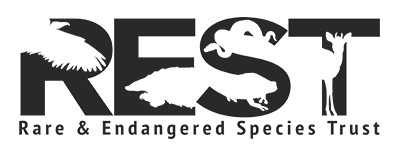Conservation
REST’s number one aim in being a good wildlife centre is to practice good conservation first. Founder, Maria Diekmann feels strongly that although research and education are key, conservation of a species must take priority. Extinction makes all other aspects irrelevant to survival. Of course research and education benefit from such efforts.Vultures
With this in mind, REST was the first in Africa to fit a satellite tracking unit on a vulture in 2004. From there, RESTs satellite successes grew to eventually having tracking on 6 Cape Griffons and 1 suspected hybrid.
This was all done since Namibia’s last Cape Griffon vulures were going extinct due to a number of issues including;
- Poison
- Water reservoir drownings
- Trade from traditional healers
- Land degidation
Since then, many organizations have developed similar projects and we are now able to form combine information in informal working groups and formal scientific research papers.
Through exposure of the issue, more parties began supporting the effort and the population was slowly built up with some translocations of birds from South Africa. Breeding seemed to start back on the Waterberg Plateau cliffs and we thought success within our reach.
Then about 6 years ago, REST noticed a serious decline in the number of birds visiting our long running weekly feeding site. The drop was at first attributed to building and having moved to a new home, but it soon became apparent there was a massive decline. After a number of high profile poisoning events around Southern Africa, researchers had to admit that elephant and rhino poachers had gotten a jump on us with poachers baiting large carcases after removing ivory or horn in order to directly kill any vultures that would land, eat and then fly up in large numbers on the next circling thermals (gusts of wind) thus giving away the position of the dead animal.
It is believed we have now experienced one of the most massive declines of any species with as much as 50-80% of all southern African vultures having died due to these practices. REST believes that Namibia and the entire southern African region have already begun to see the effects of this decimation. Vultures having been proven to be immune to diseases like anthrax, botulism and rabies seem to be more inhibitors of disease spreading than actually spreading it themselves. Thus we must begin to seriously question what we are going to do about this far-reaching problem. Anthrax has historically occurred in Etosha National Park and the far north. Can we as Namibians afford financially, environmentally and ethically to continue to put this problem on a back burner when it could eventually affect our tourism (decreasing animal populations in wild areas), our stock farming (diseases spreading from wild to domestic animals) and our human population (all of these diseases can affect human health and there is no preventive immuniation again anthrax)?
In 2015, most African vultures species were upgraded from Vulnerable/ Endangered to Critically Endangered by the IUCN in recognition of this crisis. Namibia’s Ministry of Environment and Tourism (MET) in conjunction with the Namibian Chamber of Environment has formed a stakeholder group to see what solutions can be found to not only mitigate the poison problems, but also begin to slowly re-establishing vulture populations.
Pangolins
The Cape pangolin is one of 8 pangolin species found worldwide, and the only one that can live in arid conditions. Pangolins are now labelled as the world’s most trafficked mammal. This is the worst label a species can receive. Ironically, it may be the saving grace for these shy elusive creatures. Until that label, so little was known about pangolins that most of the world didn’t know of their plight simply because they didn’t know about pangolins in general.
FROGS, SNAKES & DIK DIK
Of the remaining “Forgotten 5”, frogs worldwide have come close to extinction in many cases due to the disease chytridiomycosis. REST hopes in the next few years to be able to focus again on the spotted rubber frog, listed as Namibia’s least known frog. In addition we hope to fit trackers onto Dik Dik to see if the myths about their strong partnerships are true. Lastly, we would love to work with snake specialists in order to track the little known Dwarf python, which is often smuggled for the illegal captive breeding trade.
Vulture Friendly Farms
Farmers who embrace the discontinuation of poison use on their farms and adopt other alternatives to protect their livestock are being awarded a beautifully designed sign to be posted on the landowners’ gate to demonstrate to the community that they practice ‘vulture friendly’ land management. These attractive and eye catching signs are sponsored by the Global Environmental Fund of the UNDP.



